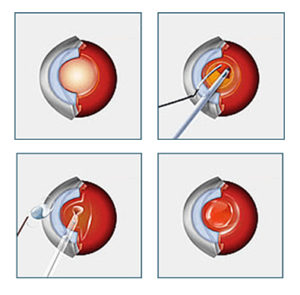
What is a cataract?
Inside everyone’s eye is a lens. Just like with a camera, the lens of your eye helps you focus on things whether they’re nearby or far away. To work well, that lens must be clear. As you age, the lens in your eye gradually becomes cloudy and causes blurry vision. We call this cloudy lens a cataract. Looking through a cloudy lens is like looking through a dirty window – everything is blurred.
What causes a cataract?
Cataracts occur naturally as you age.
Besides aging, cataract risk factors include:
- Ultraviolet radiation from sunlight or other sources
- Diseases such as diabetes, hypertension, or obesity
- Smoking or significant alcohol consumption
- Certain medications
- Previous eye injuries, inflammation, or surgeries
- Family history
How do I treat a cataract?
Over time, a cataract will become more and more cloudy. The only way to restore your vision is to remove the cataract surgically and replace the lens with a new lens implant.
Cataract surgery is the most common surgical procedure performed on adults in the United States. The procedure is performed on an outpatient basis and generally takes a half-hour or less. The recovery time is usually only a few days.
What happens during cataract surgery?
Cataract surgery is one of the safest surgical procedures performed today. Recent technological and surgical advances have made it a more gentle and reliable process than ever before.
Before cataract surgery, the eye is anesthetized. The surgeon then makes a tiny incision at the edge of the cornea. The front portion of the lens is opened, and the cataract is removed. An intraocular lens (IOL) is inserted in place of the patient’s natural lens.
At South East Eye, we offer both traditional and laser-assisted cataract surgery. During traditional cataract surgery, incisions are made by hand. Laser cataract surgery accomplishes the same tasks with a highly sophisticated, computer-guided laser.
Can cataracts grow back?
Cataracts cannot grow back. In some instances, however, cells begin to collect behind the new lens, resulting in a “secondary cataract.”
When this happens, the doctor can clear the capsular haze by applying laser treatment to the posterior capsule. This clears away the clouded cells, and is known as YAG Laser Surgery.
What are your premium lens options?
At South East Eye, we offer AcrySof® ReSTOR and TECNIS® Symfony multifocal intraocular lenses.
These lenses utilize sophisticated diffractive and refractive properties in order to greatly improve patients’ vision following cataract surgery, as well as provide increased ranges of clear vision. With advanced premium lenses, reliance on reading glasses or bifocals can be greatly reduced!
Clinical studies have demonstrated that 80% of patients who receive these lenses wear glasses little or none of the time.
For patients with clinically significant astigmatism, we recommend toric intraocular lenses. These premium lenses make it possible to surgically correct the cataracts clouding your vision andthe astigmatism blurring your vision at the same time!
What should I expect after cataract surgery?
After your surgery is complete, your doctor will provide you and your loved ones with aftercare instructions to help protect your vision during the recovery period. You will likely be prescribed antibiotic eye drops (to prevent instruction) and anti-inflammatory eye drops (to reduce inflammation).
You will be unable to drive yourself home after the procedure, so it is essential that you have someone with you. You will be provided with sunglasses to keep your eyes safe from bright light, as well as eye shields to prevent you from rubbing your eyes.
It may take several days before you completely adjust to your new vision. Some bruising is normal, as well as red and bloodshot eyes.
We will meet with you the day after your procedure to gauge your recovery progress.







